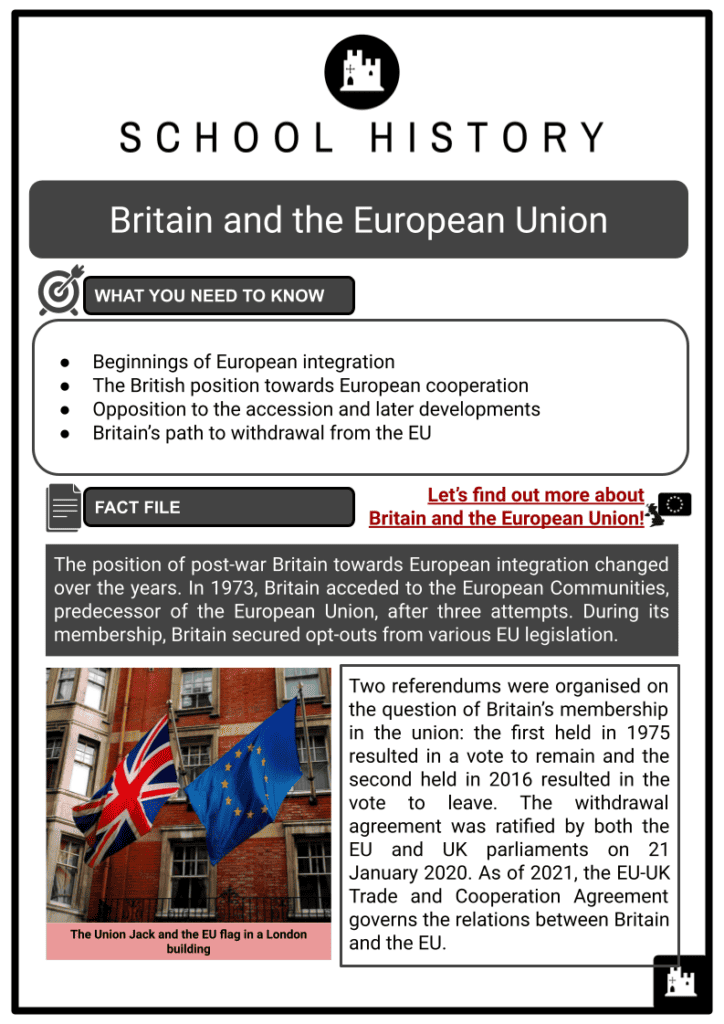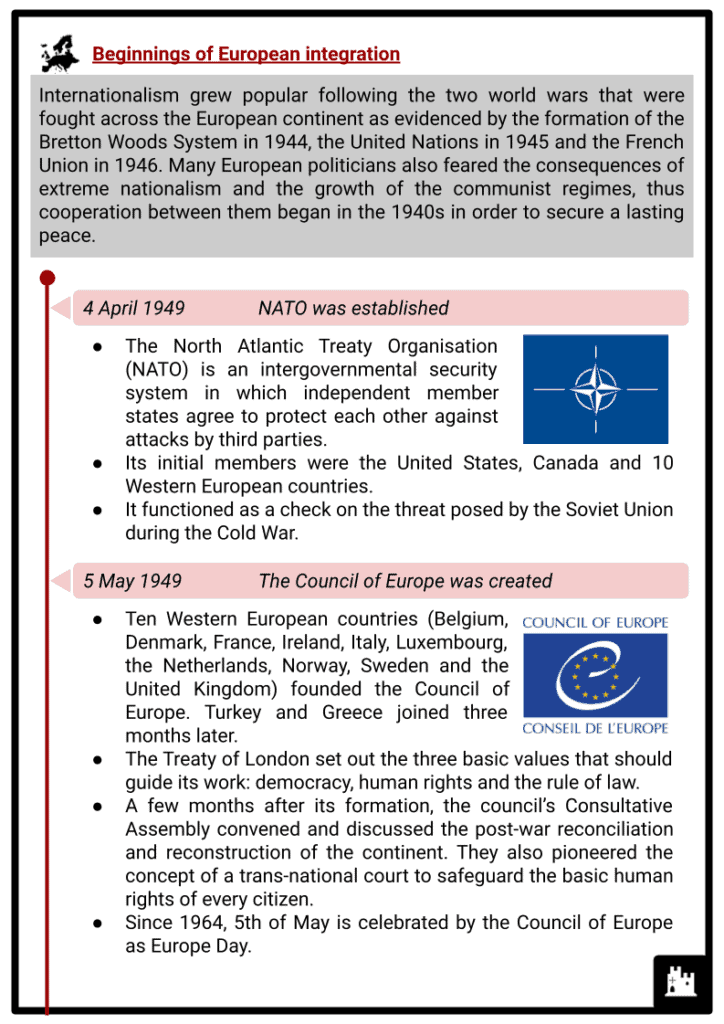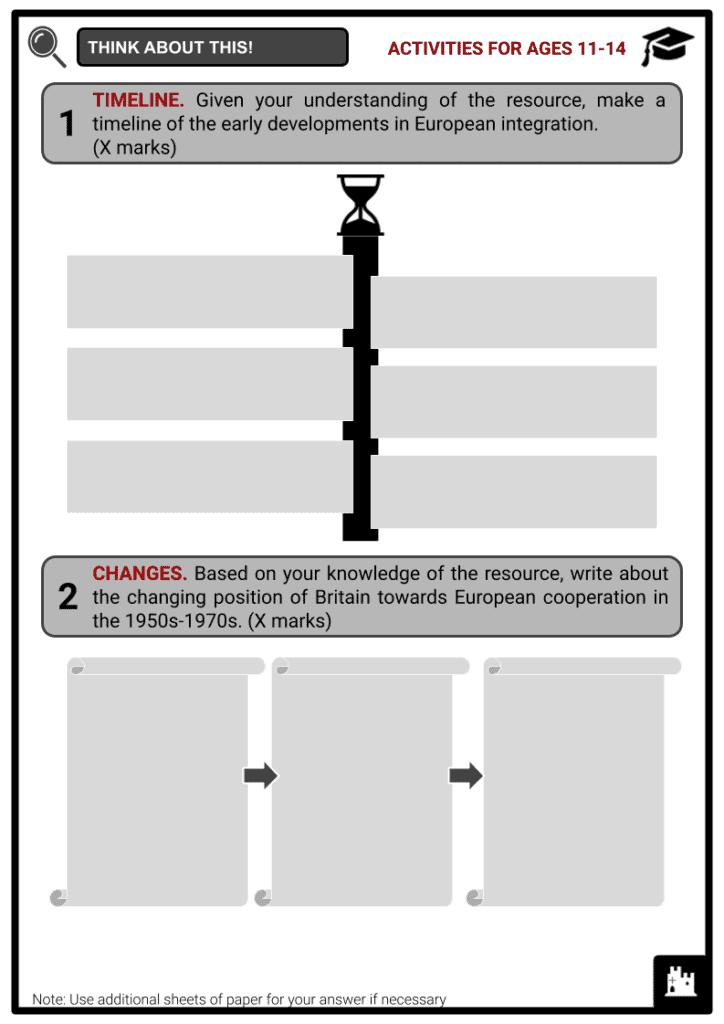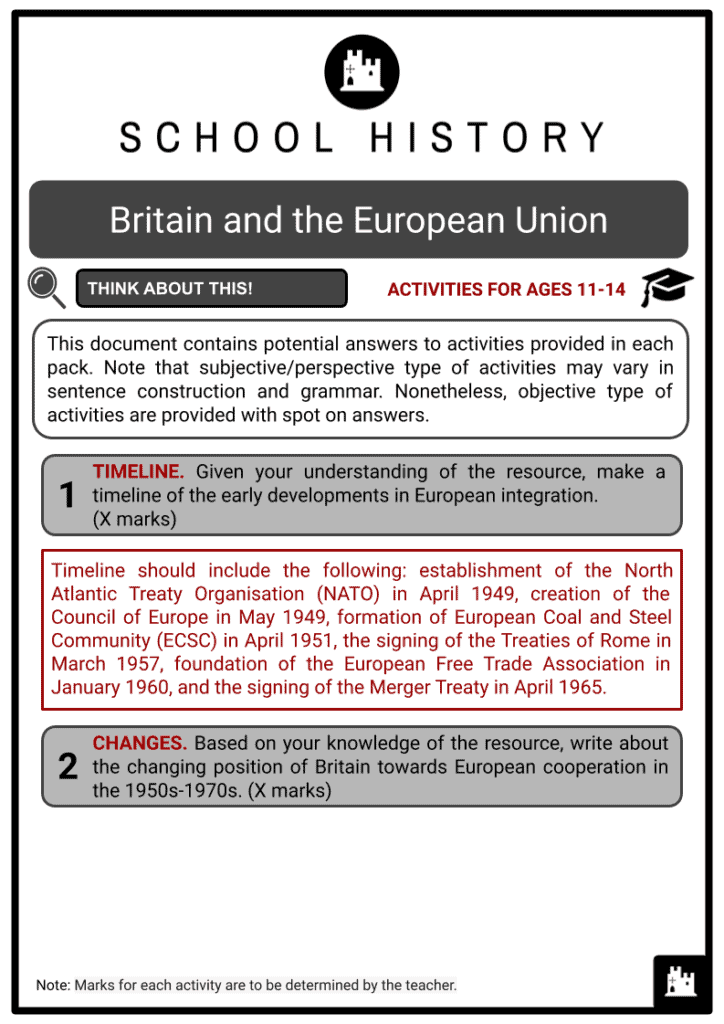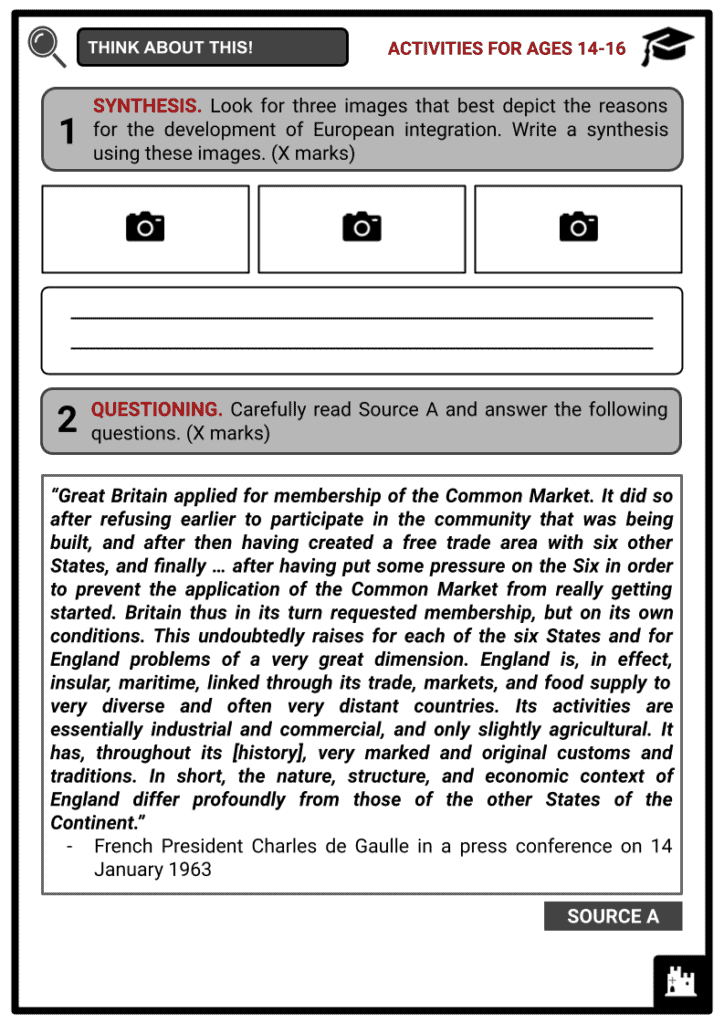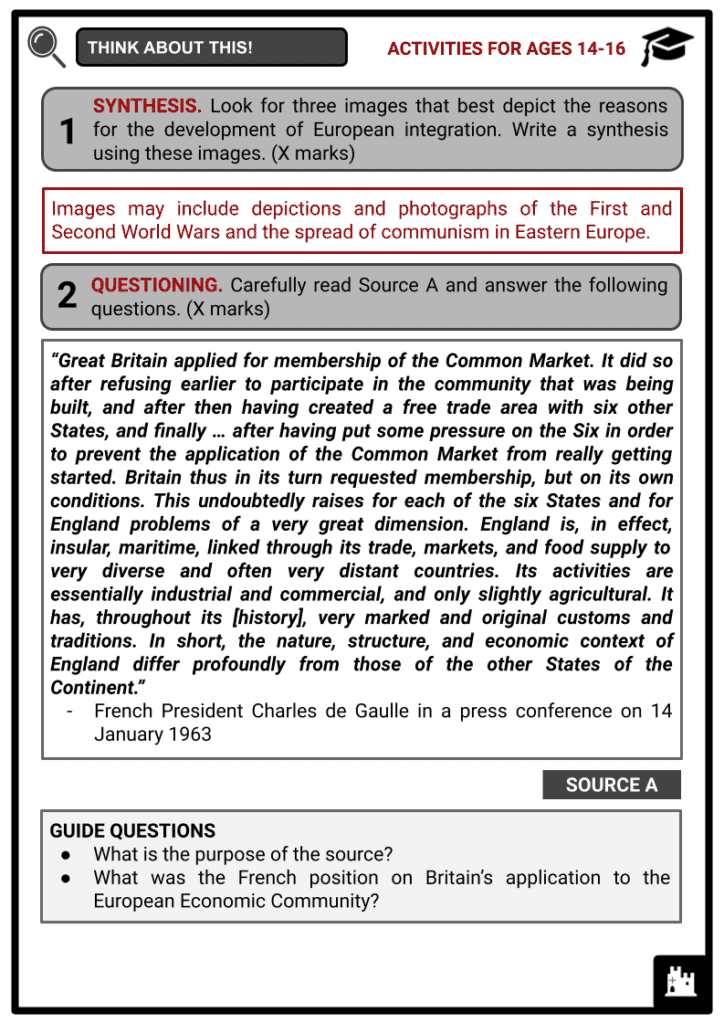Britain and the European Union Worksheets
Do you want to save dozens of hours in time? Get your evenings and weekends back? Be able to teach about Britain and the European Union to your students?
Our worksheet bundle includes a fact file and printable worksheets and student activities. Perfect for both the classroom and homeschooling!
Summary
- Beginnings of European integration
- The British position towards European cooperation
- Opposition to the accession and later developments
- Britain’s path to withdrawal from the EU
Key Facts And Information
Let’s find out more about Britain and the European Union!
The position of post-war Britain towards European integration changed over the years. In 1973, Britain acceded to the European Communities, predecessor of the European Union, after three attempts. During its membership, Britain secured opt-outs from various EU legislation.

Two referendums were organised on the question of Britain’s membership in the union: the first held in 1975 resulted in a vote to remain and the second held in 2016 resulted in the vote to leave. The withdrawal agreement was ratified by both the EU and UK parliaments on 21 January 2020. As of 2021, the EU-UK Trade and Cooperation Agreement governs the relations between Britain and the EU.
Beginnings of European integration
- Internationalism grew popular following the two world wars that were fought across the European continent as evidenced by the formation of the Bretton Woods System in 1944, the United Nations in 1945 and the French Union in 1946. Many European politicians also feared the consequences of extreme nationalism and the growth of the communist regimes, thus cooperation between them began in the 1940s in order to secure a lasting peace.
- 4 April 1949 NATO was established
- The North Atlantic Treaty Organisation (NATO) is an intergovernmental security system in which independent member states agree to protect each other against attacks by third parties.
- Its initial members were the United States, Canada and 10 Western European countries.
- It functioned as a check on the threat posed by the Soviet Union during the Cold War.
- 5 May 1949 The Council of Europe was created
- Ten Western European countries (Belgium, Denmark, France, Ireland, Italy, Luxembourg, the Netherlands, Norway, Sweden and the United Kingdom) founded the Council of Europe. Turkey and Greece joined three months later.
- The Treaty of London set out the three basic values that should guide its work: democracy, human rights and the rule of law.
- A few months after its formation, the council’s Consultative Assembly convened and discussed the post-war reconciliation and reconstruction of the continent. They also pioneered the concept of a trans-national court to safeguard the basic human rights of every citizen.
- Since 1964, 5th of May is celebrated by the Council of Europe as Europe Day.
- 18 April 1951 European Coal and Steel Community was formed
- On 9 May 1950, French Foreign Minister Robert Schuman declared that “the solidarity in production” from pooling “coal and steel production” would make war between the two “not only unthinkable but materially impossible”.
- Based on the Schuman Declaration, six countries (Belgium, France, West Germany, Italy, Luxembourg and the Netherlands) signed the Treaty of Paris to run their coal and steel industries under a common management, thus establishing the European Coal and Steel Community (ECSC).
- This resulted in the creation of a common market among member states that set forth the free movement of goods and barred states from introducing unreasonable, competitive or discriminatory practices.
- The treaty came into force on 24 July 1952 and its terms were enforced by four institutions of the ECSC: the High Authority, the Common Assembly, the Special Council of Ministers and the Court of Justice.

Signing ceremony for the Treaties of Rome in 1957
- 25 March 1957 The Treaties of Rome were signed
- Following the success of the Treaty of Paris (1951), the six ECSC countries sought to broaden cooperation to other economic sectors and the development of nuclear power by signing two pacts.
- The treaties came into force on 1 January 1958, creating the European Economic Community (EEC) and the European Atomic Energy Community (Euratom). They recommended the:
- progressive reduction of customs duties
- the creation of a customs union
- the establishment of a single market for goods, labour, services, and capital across member states
- the formation of a Common Agriculture Policy, a Common Transport Policy and a European Social Fund
- the establishment of the European Commission
- 19 March 1958 The European Parliamentary Assembly first met
- The European Parliamentary Assembly began as the Common Assembly of the ECSC which was also shared with the EEC and Euratom.
- Held in Strasbourg, France, it elected Robert Schuman as its president.
- On 30 March 1962, it changed its name to the European Parliament.
- 4 January 1960 European Free Trade Association was founded
- In order to promote free trade and economic integration between certain countries, a Convention signed in Stockholm formed the European Free Trade Association (EFTA).
- The association’s founding member states were Austria, Denmark, Norway, Portugal, Sweden, Switzerland and the UK, all of which were not part of the EEC.
- Unlike the EEC, it did not operate common external customs tariffs and each of its members were free to set up its individual customs duties against, or its individual free trade agreements with, non-members.
- 8 April 1965 The Merger Treaty was signed
- Known as the Treaty of Brussels, the Merger Treaty combined the executive institutions of the ECSC, Euratom and the EEC.
- It came into force on 1 July 1967. As a result of this treaty, the three earlier organisations, whilst remaining legally independent, were together known as the European Communities (EC).
- The treaty further stipulated that
- the Commission of the European Communities should replace the High Authority of the ECSC, the Commission of the EEC and the Commission of Euratom
- the Council of the European Communities should replace the Special Council of Ministers of the ECSC, the Council of the EEC and the Council of Euratom
The formation of the EC is regarded as the beginning of the modern European Union.
The British position towards European cooperation
- Following the end of the Second World War, there emerged proposals for the establishment of a common external tariff among European countries. In the UK, there was widespread political opposition to British participation in such union as it was feared that it would not be beneficial to the British Empire and the Commonwealth of Nations.
- When the ECSC was formed in 1951, the UK remained an observer to its creation. This revealed the detached attitude of the UK to moves toward European economic integration. The reasons for this early rejection were economic and political in nature.
- In 1952, the UK was the first country to set up a Delegation in Luxembourg, the seat of the High Authority of the ECSC at the time.
- In 1953-56, discussions between the High Authority and the British about establishing an association were proposed and carried out. This resulted in the agreement between the two to open tariff negotiations.
- During the negotiations of the Treaties of Rome, Britain mainly continued to be an observer as it still largely favoured to protect trading connections with the Commonwealth countries. Nevertheless, political opinion in Britain began to favour greater engagement with other European countries.
- In 1960, the British government proposed a rival organisation to the EEC and signed the Stockholm Convention that created the EFTA.
- Britain’s participation in the EFTA was based on its desire to form a free trade area that would enable Britain to trade with six other European states, whilst maintaining its imperial preference system especially for agricultural products.
- However, EFTA was not a strong competitor for the EEC and failed to set up a profitable free trade area.
- The early 1960s saw UK Prime Minister Harold Macmillan finally seeking to join the EEC in order to improve Britain’s economic performance and to uphold the nation’s prestige and status.
- However, Britain’s application was vetoed by the French President Charles de Gaulle in 1963.
- In the 1960s, the EEC member states were able to recover from the world wars. On the contrary, Britain’s role in international affairs diminished.
- Consequently, UK PM Harold Wilson made a new application to the EEC in 1967, which again was vetoed by de Gaulle.
- Britain’s accession to the EC was made possible following the resignation of de Gaulle from the presidency in 1969.
- The new French President Georges Pompidou removed France’s opposition to Britain’s application after The Hague Summit in December 1969. The Summit stimulated new prospects for the building of a united Europe. This made enlargement of the EC a possibility.
- In 1970, negotiations gradually started. In 1972, a referendum on the expansion of the EC’s membership was passed.
- The Treaty of Accession 1972 was subsequently passed in three EFTA states including the UK under Edward Heath’s premiership. The UK Parliament then passed the European Communities Act 1972 which made legal provision for Britain’s accession to the ECSC, EEC and Euratom. It came into force on 1 January 1973. Over 300 events took place in Britain as part of a two-week “Fanfare for Europe” programme presenting music, art, entertainment and sport from national and European performers.
Opposition to the accession and later developments
- Following its enlargement, the EC had turned into a much broader entity. In the UK, the accession had been met with opposition in Parliament as many still had doubts about European integration. Direct consultation with the citizens was not held in Britain when the Treaty of Accession was signed or when the European Communities Bill went through the legislative process.
- Prior to the general election of October 1974, the Labour Party’s manifesto committed to hold direct consultation with the people to decide whether the UK should remain in the EC.
- Soon after the Labour government of Harold Wilson came into office, a referendum began to be organised.
Referendum of 1975
- The Referendum Bill went through Parliament and received royal assent on 8 May 1975, just under a month before the vote took place.
- In the referendum on 5 June 1975, the British electorate had to provide a simple YES/NO answer to the question: “Do you think that the UK should stay in the European Community (the Common Market)?”
- In total, over two-thirds of the votes supported continued EC membership.
- The results gave a strong democratic legitimacy to the decision to join and remain in the EC.
Developments in the 1970s-1990s
- In 1979, the European Monetary System (EMS) officially came into force. It was a multilateral adjustable exchange rate agreement in which the majority of the EEC states linked their currencies to prevent huge fluctuations in relative value. It was the precursor to the creation of the euro currency. The UK exempted itself from adopting the EMS.
- In the 1983 general election, the opposition Labour Party campaigned on a commitment to terminate Britain’s EC membership without a referendum. The Conservative government of Margaret Thatcher was re-elected.
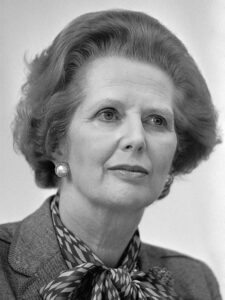
Conservative PM Margaret Thatcher - In 1986, the Single European Act launched a six-year programme to arrange free trade across the borders between EC member countries with the intention to create a single market. This act granted the European Parliament more say and reinforced the power of the EC in environmental protection. This act was supported by the Thatcher government.
- In 1990, the UK, under the Thatcher government, joined the European Exchange Rate Mechanism (ERM) with the pound sterling pegged to other European currencies. In 1992, the Conservative government of John Major withdrew from the ERM after the pound sterling came under pressure from currency speculators.
- In 1992, the Treaty on European Union, often referred to as the Maastricht Treaty, was signed in the Netherlands. It introduced new concepts such as the euro, a European Central Bank or the European citizenship and officially changed the name of the EC to the European Union (EU) embodying the evolution of the organisation from an economic union into a political union. The act entered into force on 1 November 1993.
- With the establishment of the EU, politically sensitive areas, including foreign and security policy and justice and home affairs, continued to be intergovernmental. In 1993, the single market was finally set up, allowing for the free movement of people, goods, services and money.
Britain’s path to withdrawal from the EU
- The EU continued to gain new members and a number of states aspired to join it. Membership in the EU means the law of the EU applies in the member states. Meanwhile, member states occasionally negotiate certain opt-outs from the EU legislation, and such was the case of the UK.
What were the UK’s opt-outs from the EU legislation?
- Agreement on Social Policy of the Maastricht Treaty (1992)
- The Major ministry secured an opt-out from this policy which was related to social issues and particularly rights in the workplace.
- However, the Labour government of Tony Blair abolished this opt-out as part of the text of the Treaty of Amsterdam (1997).
- Schengen Agreement
- The UK secured a withdrawal from the Schengen Agreement that was included in the Treaty of Amsterdam (1997). This agreement removed border controls between member states.
- Despite this opt-out, the UK utilises the Schengen Information System, a governmental database used by European countries to store and disseminate information on individuals and property.
- As a result, the UK was able to exchange information with other Schengen countries, often for the sake of liaising over law enforcement.
- Economic and monetary union
- The Maastricht Treaty of 1992 included protocols on the UK, granting the country an opt-out with the right to decide if and when they would join the euro.
- The Blair ministry suggested that the UK should join the euro if five economic tests were met. These tests were not met by 2003.
- Charter of Fundamental Rights of the European Union of the Treaty of Lisbon (2007)
- The UK was worried that the Charter of Fundamental Rights of the European Union might be employed to change British labour law.
- Consequently, it secured a protocol which clarified how the Charter would interrelate with its national law.
- Area of freedom, security and justice of the EU
- In 2013, the UK exercised its opt-out of all the police and criminal justice legislation adopted prior to the Treaty of Lisbon’s entry into force.
- Whilst the UK was allowed to either withdraw from all the legislation or none of it, it later opted back into some measures.
- In 2013, the Conservative government of David Cameron proposed to hold a referendum on withdrawing from the EU. In fact, it was included in the Conservative Party’s manifesto in the 2015 general election. Negotiations were to begin soon after the general election.
- In February 2016, an agreement was reached between the UK and the rest of the EU on renegotiated membership terms should the state vote to remain a member. The EU would present suitable legislative proposals following a vote to remain.
Referendum of 2016
- The European Union Referendum Act 2015 was passed and granted legal provision for a consultative referendum.
- PM Cameron declared that the referendum would take place on 23 June 2016.
- Whilst the British government was in favour of a Remain result, cabinet ministers were permitted to campaign on either side.
- In the referendum, the British electorate voted by 51.9% to 48.1% in favour of leaving the EU, on a 72% national turnout.
- The outcome of the referendum of 2016 came as a shock throughout Europe and the rest of the world. In fact, this caused tumult in money markets and stock markets a day after the result came out.

UK PM Theresa May met with President of the European Commission Jean-Claude Juncker in October 2016 - After the Brexit vote, PM Cameron who backed remaining in the EU resigned and was succeeded by Theresa May on 13 July 2016.
- Negotiations started to process Britain’s withdrawal from the bloc. These included withdrawal and various trade agreements, which took years to be finalised.
- PM May resigned from the premiership having failed to conclude the Brexit negotiations.
- On 31 January 2020, Britain now under Boris Johnson’s government, formally left the EU becoming the first country to do so voluntarily.
- The Brexit withdrawal agreement (2020) and the EU-UK Trade and Cooperation Agreement (2021) governed the UK’s post-Brexit relationship with the EU. Apart from these pacts, a security agreement and a nuclear energy agreement were signed and ratified by the two.
- The EU-UK Trade Agreement (2021) comprises the following:
- a free trade deal with eager cooperation on economic, social, environmental and fisheries concerns
- a strong collaboration on citizen security
- an all-encompassing governance framework
- The UK has kept strong relations with several EU member states following Brexit, but it was criticised across the EU for its withdrawal and the turbulent process of negotiation that took place.
- The UK-EU relations saw gradual improvement as evidenced by the UK being invited to an EU Foreign Affairs Council meeting to discuss response to the 2022 Russian invasion of Ukraine.
- Polling companies have continued to poll respondents on re-joining the EU. Results have revealed a steady increase in the number of people wanting to re-join the EU since May 2022. In a November 2022 poll, 53% of Brits preferred to reunite with the EU if another referendum were to be held, while 34% decided to stay out and 14% were unsure.
Image Sources
- https://upload.wikimedia.org/wikipedia/commons/thumb/6/61/Union_Jack_and_the_european_flag.jpg/800px-Union_Jack_and_the_european_flag.jpg?20120727081219
- https://upload.wikimedia.org/wikipedia/en/3/35/Treaty_of_Rome.jpg
- https://upload.wikimedia.org/wikipedia/commons/thumb/f/f9/Margaret_Thatcher_%281983%29.jpg/800px-Margaret_Thatcher_%281983%29.jpg
- https://upload.wikimedia.org/wikipedia/commons/4/40/Prime_Minister_Theresa_May_met_with_Jean-Claude_Juncker%2C_President_of_the_European_Commission%2C_after_the_European_Council_meeting.jpg

